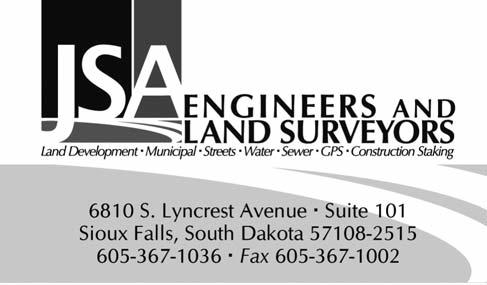
5 minute read
Risk-Sharing News
Risk-Sharing
Are Safety and Loss Control Programs a Good Investment?
Advertisement
In recent weeks I have fielded questions from a couple of entities that belong to the risk-sharing pools concerning the effectiveness of their safety programs. As I visited with government leaders from those entities the central issue became readily apparent, “what is our return on investment for a safety program?” This definitely is not a new question in the safety field. For me, the first time that I was asked this question was while I was conducting one of my very first surveys on behalf of the risk-sharing pools back in January of 1995. It was a difficult question to answer back then and it really has not become much easier to answer today. Today however, I now have 20 years of experience in watching the positive results of proactive safety programs that are working for local governmental entities in South Dakota. Unfortunately, during those same years, I have also observed the costly results for some entities that have relied basically on “luck” or have only been reactive when it comes to safety.
In recent years, large organizations such as Liberty Mutual Insurance, the National Safety Council, the American Society of Safety Engineers and the Centers for Disease Control and Prevention have tried to quantify the “Return on Investment” (ROI) for safety. Some claim that for every dollar invested in safety the ROI can be anywhere from $3 to $6 depending on which study or article that you read. Some studies also indicate that there can be between $2 and $5 of indirect costs incurred for each $1 of direct costs. Keep in mind that insurance does not cover all of your expenses for a claim, only direct costs. There are approximately 100 different indirect costs that are not covered that could come directly out of your funds. Items like overtime paid and lost or decreased productivity due to the absence of an employee because of an injury are not going to be reimbursed. Even if you are unwilling to agree with these studies I think we can all agree on this; first and foremost, no one wants to see any employee get hurt.
Here are some solid financial numbers for you to consider. The frequency and severity of the claims experienced by your entity can directly affect the amount that you pay for coverage. For workers’ compensation, each entity has an experience modifier that takes into account your claims history for the past three years. If your history is good, a credit is applied. However, if your history is not good a debit is applied. For both workers’ compensation and liability, the underwriters and actuaries look at the loss ratios for the various lines of coverage that your entity has. A loss ratio is simply the dollars paid in for coverage versus the dollars paid out and/or reserved for claims over a given period. The benchmark is a loss ratio of less than 60%. If the loss ratio is greater than 60% there is a good chance that you are going to pay more for coverage. Unfortunately, these numbers are reactive rather than proactive as they deal with claims that have already occurred.
For members of the risk-sharing pools, here are some additional financial numbers to consider. Both Pools offer members a loss control credit for their safety efforts and for implementing the loss control recommendations that we make during the surveys that we conduct for their members. These credits are given to members who are trying to be proactive by trying to reduce the potential for claims and injuries.
Safety programs do take time and a commitment by your supervisors and employees. Recently I was visiting with a Mayor of a South Dakota city that belongs to both risk-sharing pools. I had recently visited with their


safety coordinator who had volunteered to oversee the city’s safety program in addition to their regularly assigned full-time duties. The purpose of our visit was to review the progress that they had made with their program. This city is really no different than any of the other cities that we work with. The demands for service continue to increase and yet there has not been a similar increase in the number of employees to provide these services. I was telling the Mayor how pleased I was with the program that they had developed and how much of a decrease that I had seen in the claims activity for both liability and workers’ compensation. I told him that we have used some of their programs as “best practices” for other cities to follow. He told me that he was very proud of what the city had accomplished and was quick to give credit to the safety coordinator as well as the supervisors and employees. He told me that they had made safety and loss control a priority within their community. Granted there has been an investment made by this city in the development and maintenance of this program, but I’ll bet if you ask them if they are getting a “Return on Investment” from their safety program you will get a positive reply.
I am proud to say that today several cities that we work with have developed outstanding safety programs. Each has become proactive with safety and loss control in their own way and they are not relying solely on “luck” to keep their employees and the financial assets of their cities safe. Please take a minute and review the status of the safety and loss control efforts for your entity. Ask yourself these questions. Do you have an organized safety and loss control program? Do you have written safety rules for employees? Are your supervisors enforcing your written rules? What type of training are you providing new employees? Are you conducting monthly safety meetings for all employees? Are you conducting routine selfinspections of your facilities? If you can answer yes to these questions then you are on the right track in providing your employees a safe work environment.
Remember safety is a top-down process. To be effective, a safety program has to have the support of the Mayor and governing board along with your department heads and supervisors. If you do not have a program, we can help you start one so you can begin to reap the benefits. For those of you that have a safety program, please feel free to use the many safety and loss control services that both risksharing pools provide for their members at no cost. To see a list of these services go to www.sdmlwcfund.com or www.sdpaaonline.org.
Doug Kirkus, Loss Control Consultant South Dakota Public Assurance Alliance SDML Workers’ Compensation Fund dkirkus@safety-benefits.com 888-313-0839










